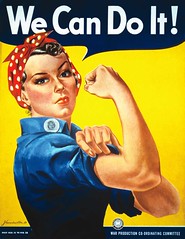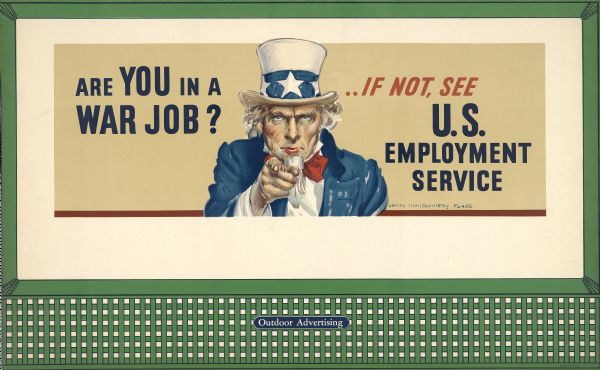Propaganda
"Posters Help Win the War at Home"
by Sandy Webbere
Reprinted with permission from the Tar Heel Junior Historian. Spring 2008.
Tar Heel Junior Historian Association, NC Museum of History
"In the time of war what is said on the enemy’s side . . . is always propaganda, and what is said on our side . . . is truth and righteousness.”
—Walter Lippman (1889–1974), journalist, writer, political commentator
Propaganda relies on the emotions and beliefs of individual people to control popular opinion. Before World War I, President Woodrow Wilson used posters to convince Americans to enter the war on the side of the British. It was during this period (1917– 1918) that posters became a vital tool to achieve a national goal—winning a war!
World War II will be remembered for many things, including all the different battle fronts, bombs, and bombers like the Enola Gay, which dropped the first atomic bomb on Hiroshima, Japan, on August 6, 1945.
In North Carolina and across America, another important battle was waged through the use of propaganda posters. Posters provided the psychological ammunition needed to convince Americans that the war was right, and their side would (and should) win. But the line between truth and propaganda could be a fine one. Both sides—the Allied (the “good”) and the Axis (the “evil”) powers—manipulated public opinion in order to keep up enthusiasm and morale at home and convince everyone of their responsibilities to help the soldiers overseas.
By June 1942 the federal government of the United States, private industry, and communities were producing posters. President Franklin Roosevelt created the Office of War Information (OWI) to distribute posters to every American post office, school, library, store, restaurant, and railroad station.
Posters were distributed at the beginning of each month. Adults and children were happy to “make do or do without.” They volunteered, recycled, and contributed to the effort to win the war. Posters’ messages linked the military front with the home front, using some common themes.
Women Mobilized—We Can Do It!
Before World War II, most American women were housewives who stayed at home after they got married. When the men went off to war, massive labor shortages resulted. Posters glorified and glamorized women doing their part in the factory, office, and military, a major component in the Allies’ victory.
Because You Talked—Keep Quiet!
The government alerted citizens to the presence of enemy spies: “Words are ammunition.” Americans felt that the enemy was everywhere and would be listening to their conversations about troop locations and movements. Posters warned everyone that their loved one might end up being killed if they started rumors.
Reaching Out to Meet the Needs
Posters informed diligent citizens that, through recycling efforts, the lives of their husbands, fathers, sons, and brothers would be saved. Children collected scrap metal, toys, bicycles, and paper to be transformed into jeeps, tanks, planes, and other needs. They even collected cooking fat to be used in making bombs!
Rationing—“Don’t you know there’s a war on?”
Posters reminded everyone that the military got first priority on supplies. Throughout the United States, shortages and rationing became part of daily life. People received only three gallons of gasoline for their cars per week! For most of the war, no American cars or tires were produced for the home front. Everything made was sent to the battle front.
American posters won the hearts, minds, and support of people on the home front and made World War II everybody’s war. Each poster had an important message. Across the country, young and old successfully volunteered, supported rationing, collected scrap metal, or worked in factories. Inexpensive to produce and ever-present, posters appealed to patriotism and made common war goals everyone’s business.
*At the time of the publication of this article, Sandy Webbere was an associate curator at the North Carolina Museum of History. Her specialties included the home front during America’s wars, the Revolutionary War period, celebrations, recreation, and other topics.
Additional Resources:
WWI & WWI Propaganda Posters: http://www.propagandaposters.us/
LearnNC: Wake Up, American- World War I Propaganda Posters: http://www.learnnc.org/lp/editions/ww1posters
DocSouth: North Carolinians and the Great War: https://docsouth.unc.edu/wwi/posters.html
The National Archives: Powers of Persuasion: http://www.archives.gov/exhibits/powers_of_persuasion/powers_of_persuasi...
Video and Image Credits:
October, 2011. "Rosie The Riveter." Located at https://www.flickr.com/photos/midgro22/6299926854/. Accessed February 28, 2012.
Wisconsin Historical Images. United States. War Manpower Commission. "Design No. 3 - Uncle Sam." 66860.1943. Accessed August 10, 20232 at https://www.wisconsinhistory.org/Records/Image/IM66860.
World War I Propaganda Posters: The U.S. Joins the Fight. YouTube. History Channel, 2017. Accessed August 10, 2023 at https://youtu.be/pT8Y_Ok5V54.
1 January 2008 | Webbere, Sandy

